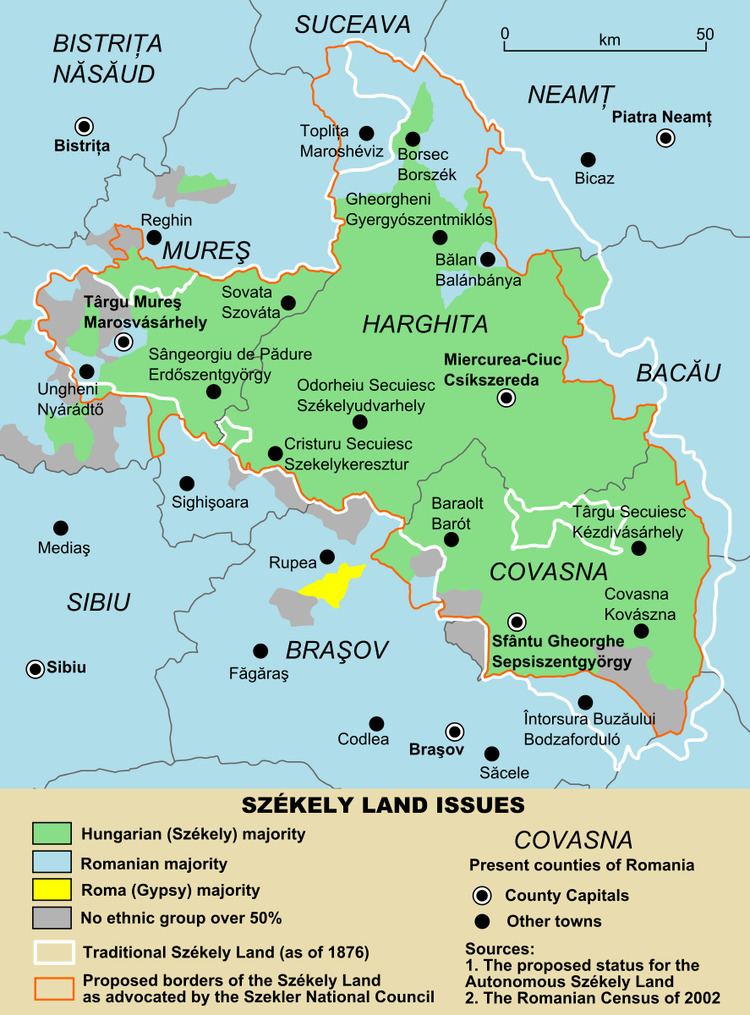 | ||
The Székely Land (Szeklerland) is a region of central Romania. The primary goal for the Hungarian political organisations in Romania is to achieve Szekler autonomy. The Szeklers make up about half of the Hungarians in Romania and live in an ethnic block. According to official data from the Romania's 2011 census, 609,033 persons in Mureş, Harghita and Covasna counties consider themselves Hungarian (56.8% of total population of the three counties). The Székelys (Szeklers), a Hungarian sub-group, are mainly concentrated in these three counties.
Contents
Political organizations
The most important political organisation of ethnic Hungarians in Romania is the Democratic Alliance of Hungarians in Romania, which undertakes to represent all Hungarians in Romania (i.e. not only those living in the Székely Land). The demand for Hungarian autonomy has been part of their program since 1993.
In 2014, the Hungarian Civic Party signed a settlement with the Democratic Union of Hungarians in Romania about cooperation and joint support for Hungarian autonomy.
The Hungarian People's Party of Transylvania also stands for Hungarian autonomy in Transylvania.
Events
A Szeklerland based organization, the Szekler National Council held a peaceful demonstration in Odorheiu Secuiesc on March 15, 2006, in favor of autonomy where 4,000 to 10,000 people took part. Five days before this, President Traian Băsescu met with Jenő Szász (the mayor of Odorheiu Secuiesc and also president of the Hungarian Civic Union), who assured the president of the peaceful character of the March 15 ceremonies and also briefly presented the UCM's vision on autonomy. On March 16 Băsescu visited the town and met with local and county officials. Băsescu declared that the Romanian administrative system should be more decentralized, but only in a symmetrical way, with no more autonomy given to the Székely Land than to any other region in Romania.
On February 12, 2007, Hungarian President László Sólyom visited Romania and met Băsescu. The discussions included the controversial topics of minority rights and autonomy. Băsescu has pointed out that the situation of the Székely in Romania is in full compliance with the standards of the European Union. He also mentioned that a referendum for territorial autonomy would be illegal and characterized the Székely initiative not as a test of the public opinion, but as a test of Romanian laws. Romania's Interior Ministry has said that organizing an informal poll is not illegal.
On 10 March 2013 thousands gathered to demonstrate for Szekler autonomy. László Tőkés also participated on the march. The protest was called "Székely Szabadság Napja" (the day of the Szekler freedom).
In Autumn 2013, the "Great Szekler's March for Autonomy" was held with thousands of people who formed a 53-kilometer long human chain in Szeklerland.
On 10 March 2014 thousands demonstrated for Szekler autonomy in Târgu Mureș. The program bore the same name as the earlier "Székely Szabadság Napja" ("the day of the Szekler freedom"). .
Views of political parties
Territorial autonomy for the Székely Land was supported by the former People's Action Party, headed by former president Emil Constantinescu.
Constitutional issues
Article 1 of the Romanian Constitution defines the country as a "sovereign, independent, unitary and indivisible national state." It has often been argued that, as a result of this provision, any ethnic-based territorial autonomy, including that of the Székely Land, would be unconstitutional.
